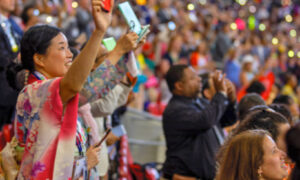THE Christmas season is here. What does that mean to you, your family, and your associates? Is it a spiritual occasion, or is it only a festive and merry period? Is it a time to reflect on the birth of Jesus Christ or not to be concerned about Christian norms?
In considering those questions, bear in mind that Christmas traditions may differ according to where you live. For instance, in Mexico and other Latin-American countries, even the name is different. One encyclopedia points out that the English name Christmas “is derived from the medieval Christes Masse, the Mass of Christ.” However, La Navidad, or the Nativity, as it is called in these Latin-American lands, refers to the nativity, or birth, of Christ. Take a moment to consider some details from Mexico. This may help you to shape your own opinion about this holiday season.
The Posadas, “the Three Wise Men,” and the Nacimiento
The festivities begin on December 16 with the posadas. The book Mexico’s Feasts of Life comments: “It is the time of the posadas, nine magical days leading up to Christmas Eve, which commemorate the lonely wandering of Joseph and Mary in the city of Bethlehem and the moment when they at last found kindness and shelter. Families and friends gather together nightly to reenact the days preceding the birth of Christ.”
Traditionally, a group of people carries images of Mary and Joseph to a home and in song asks for shelter, or posada. Those in the house sing in reply until the visitors are finally given admittance. Then begins a party, where some—blindfolded and with a stick in hand—take turns trying to break the piñata, a large decorated earthenware pot that hangs from a cord. Once broken, its contents (candy, fruit, and the like) are gathered by the celebrants. This is followed by food, drinks, music, and dancing. Eight posada parties are held from December 16 through December 23. On the 24th, Nochebuena (Christmas Eve) is celebrated, and families make an effort to be together for a special dinner.
Before long comes New Year’s Day, celebrated with very noisy parties. On the evening of January 5, the Tres Reyes Magos (“three wise men”) are supposed to bring toys for the children. The climax is a party on January 6, when a rosca de Reyes (ring-shaped cake) is served. As this pastry is eaten, somebody will find in his piece a little doll representing the baby Jesus. The finder is obliged to organize and host a final party on February 2. (In some places there are three little dolls, representing “the three wise men.”) As you can see, the partying in connection with Christmas goes on and on.
During this period, the nacimiento (Nativity scene) is quite prominent. What is involved in this? Well, in public areas as well as in churches and homes, scenes are set up with figures (large or small) made out of ceramic, wood, or clay. They represent Joseph and Mary kneeling before a manger that holds a newborn baby. Often there are shepherds and Los Reyes Magos (“the wise men”). The setting is a stable, and some animals may round out the scene. The central figure, however, is that of a newborn baby, called in Spanish el Niño Dios (the Child God). This key figure may be placed there on Christmas Eve.
A Closer Look at Nativity Traditions
Concerning the Christmas celebration as it is generally known all over the world, The Encyclopedia Americana says: “Most of the customs now associated with Christmas were not originally Christmas customs but rather were pre-Christian and non-Christian customs taken up by the Christian church. Saturnalia, a Roman feast celebrated in mid-December, provided the model for many of the merry-making customs of Christmas. From this celebration, for example, were derived the elaborate feasting, the giving of gifts, and the burning of candles.”
In Latin America, those basic Nativity customs may be followed, along with additional ones. ‘From what source,’ you might wonder. Frankly, many who want to adhere to the Bible recognize that some customs are nothing but Aztec rites. El Universal, a newspaper in Mexico City, commented: “Friars from different orders took advantage of the fact that festivities of the Indian ritual calendar coincided with the Catholic liturgical calendar, so they used this to support their evangelizing and missionary work. They replaced the commemorations to the pre-Hispanic divinities with festivities to Christian divinities, introduced European festivities and activities, and also took advantage of the Indian festivities, which resulted in a cultural syncretism from which authentically Mexican expressions have arisen.”
The Encyclopedia Americana explains: “Nativity plays early became a part of the Christmas celebration . . . The representation in church of the crèche [the manger scene] is said to have been begun by Saint Francis.” These plays featuring the birth of Christ were performed in the churches during the beginning of the colonization of Mexico. They were organized by Franciscan monks in order to teach the Indians about the Nativity. Later the posadas became more popular. Whatever the original intention behind them, the way the posadas are held today speaks for itself. If you are in Mexico during this season, you can see or sense something that a writer for El Universal highlighted in his comment: “The posadas, which were a way to remind us of the pilgrimage of Jesus’ parents looking for a shelter where the Child God could be born, are today only days of drunkenness, excesses, gluttony, vanities, and more and more crime.”
The idea of the nacimiento emerged during Colonial times from the original live representations in churches. While some find it attractive, does it correctly represent what the Bible says? That is a valid question. When the so-called three wise men—who in fact were astrologers—visited, Jesus and his family were no longer living in a stable. Time had passed, and the family was living in a house. You will find it interesting to note this detail in the inspired record at Matthew 2:1, 11. You can also note that the Bible does not say how many astrologers there were.
In Latin America, the three wise men replace the idea of Santa Claus. Still, as is done in other lands, many parents hide toys in the home. Then on the morning of January 6, the children look for them, as if the three wise men brought them. This is a money-making time for toy sellers, and some have made a fortune on what many honesthearted people recognize is just a fantasy. The myth of the three wise men is losing credibility among a goodly number, even among little children. Though some are displeased that this myth is losing believers, what can anyone expect of a fantasy maintained only for the sake of tradition and for commercial convenience?
Christmas, or the Nativity, was not celebrated by early Christians. One encyclopedia says about this: “The celebration was not observed in the first centuries of the Christian church, since the Christian usage in general was to celebrate the death of remarkable persons rather than their birth.” The Bible links the celebration of birthdays with pagans, not with God’s true worshipers.—Matthew 14:6-10.
This does not, of course, mean that it is not beneficial to learn and remember the actual events involved in the birth of the Son of God. The factual Bible account provides important insights and lessons for all those who want to do God’s will.
Birth of Jesus According to the Bible
You will find reliable information about Jesus’ birth in the Gospels of Matthew and Luke. They show that the angel Gabriel visited a young unmarried woman by the name of Mary in the Galilean town of Nazareth. What message did he deliver? “Look! you will conceive in your womb and give birth to a son, and you are to call his name Jesus. This one will be great and will be called Son of the Most High; and Jehovah God will give him the throne of David his father, and he will rule as king over the house of Jacob forever, and there will be no end of his kingdom.”—Luke 1:31-33.
Mary was very surprised by this message. Not being married, she said: “How is this to be, since I am having no intercourse with a man?” The angel answered: “Holy spirit will come upon you, and power of the Most High will overshadow you. For that reason also what is born will be called holy, God’s Son.” Mary, recognizing that this was the will of God, said: “Look! Jehovah’s slave girl! May it take place with me according to your declaration.”—Luke 1:34-38.
An angel told Joseph about the miraculous birth so that he would not divorce Mary, which he was planning to do after he learned of her pregnancy. He was then willing to assume the responsibility of taking care of the Son of God.—Matthew 1:18-25.
Then a decree from Caesar Augustus forced Joseph and Mary to travel from Nazareth in Galilee to Bethlehem in Judea, the city of their forefathers, to be registered. “While they were there, the days came to the full for her to give birth. And she gave birth to her son, the firstborn, and she bound him with cloth bands and laid him in a manger, because there was no place for them in the lodging room.”—Luke 2:1-7.
Luke 2:8-14 describes what followed: “There were also in that same country shepherds living out of doors and keeping watches in the night over their flocks. And suddenly Jehovah’s angel stood by them, and Jehovah’s glory gleamed around them, and they became very fearful. But the angel said to them: ‘Have no fear, for, look! I am declaring to you good news of a great joy that all the people will have, because there was born to you today a Savior, who is Christ the Lord, in David’s city. And this is a sign for you: you will find an infant bound in cloth bands and lying in a manger.’ And suddenly there came to be with the angel a multitude of the heavenly army, praising God and saying: ‘Glory in the heights above to God, and upon earth peace among men of goodwill.’”
The Astrologers
Matthew’s account mentions that astrologers from the East came to Jerusalem looking for the place where the King of the Jews was born. King Herod was very interested in this—but not with good intentions. “Sending them to Bethlehem, he said: ‘Go make a careful search for the young child, and when you have found it report back to me, that I too may go and do it obeisance.’” The astrologers found the young child and “opened their treasures and presented it with gifts, gold and frankincense and myrrh.” But they did not go back to Herod. “They were given divine warning in a dream not to return to Herod.” God used an angel to warn Joseph of Herod’s intentions. Joseph and Mary then fled to Egypt with their son. Next, in an effort to eliminate the new King, cruel King Herod ordered the killing of boys in the Bethlehem area. Which boys? Those two years of age and under.—Matthew 2:1-16.
What Can We Learn From the Account?
The visiting astrologers—however many of them there were—did not worship the true God. The Bible version La Nueva Biblia Latinoamérica (1989 Edition) states in a footnote: “The Magi were not kings, but fortune-tellers and priests of a pagan religion.” They came in line with their knowledge of the stars to which they were devoted. Had God wanted to guide them to the young child, they would have been led to the exact place without needing to go first to Jerusalem and to Herod’s palace. Later on, God did intervene to alter their course to protect the child.
At Christmastime this account is often surrounded by a mythical and romantic atmosphere that obscures the most important thing: that this baby was born to be a magnificent King, as was announced to Mary and to the shepherds. No, Jesus Christ is not a baby anymore, or even a child. He is the ruling King of God’s Kingdom, which very soon will eliminate all rulerships opposed to God’s will, and he will solve all problems of mankind. That is the Kingdom we ask for in the Lord’s Prayer.—Daniel 2:44; Matthew 6:9, 10.
Through the angels’ declaration to the shepherds, we learn that the opportunity for salvation is open to all who are willing to hear the message of the good news. Those who gain the favor of God become “men of goodwill.” There are marvelous prospects for peace in all the world under the Kingdom of Jesus Christ, but people must be willing to do God’s will. Is the Christmas season conducive to this, and does it reflect that desire? Many sincere people who want to follow the Bible feel that the answer is obvious.—Luke 2:10, 11, 14.
Another detail should not be ignored: In the Mexican nacimiento, the baby is referred to as “the Child God” with the idea that it was God himself who came to earth as a baby. However, the Bible presents Jesus as being the Son of God who was born on earth; he was not the same as or equal to Jehovah, the almighty God. Consider the truth about this, presented at Luke 1:35; John 3:16; 5:37; 14:1, 6, 9, 28; 17:1, 3; 20:17.
SOME WOULD BE SURPRISED
In his book The Trouble With Christmas, author Tom Flynn set out conclusions reached after years spent researching Christmas:
“An enormous number of traditions we now associate with Christmas have their roots in pre-Christian pagan religious traditions. Some of these have social, sexual, or cosmological connotations that might lead educated, culturally sensitive moderns to discard the traditions once they have understood their roots more clearly.”—Page 19.
After presenting a mass of supporting information, Flynn returns to the basic point: “One of the great ironies of Christmas is how little of its content is truly Christian. Once we dispose of the pre-Christian elements, most of what remains is post-Christian, rather than authentically Christian, in origin.”—Page 155.
The announcement of Jesus’ birth set the stage for his future role as God’s chosen King





